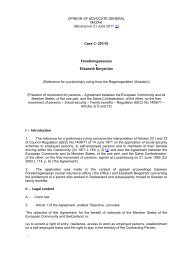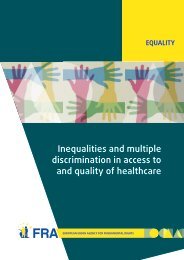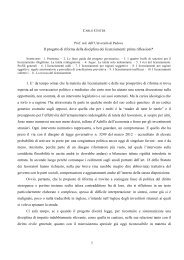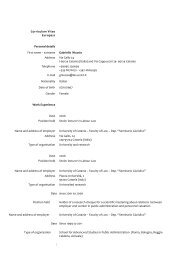Study on non-legislative initiatives for companies to promote gender ...
Study on non-legislative initiatives for companies to promote gender ...
Study on non-legislative initiatives for companies to promote gender ...
Create successful ePaper yourself
Turn your PDF publications into a flip-book with our unique Google optimized e-Paper software.
54 Gender equality <strong>initiatives</strong><br />
they more often are employed in junior positi<strong>on</strong>s. For this reas<strong>on</strong>, they comprise <strong>on</strong>ly<br />
32 % of those c<strong>on</strong>sidered as heads of businesses (chief executives, direc<strong>to</strong>rs and<br />
managers of small businesses). 9<br />
Also in other aspects of work quality 10 , gaps between women and men persist, e.g. in<br />
rec<strong>on</strong>ciling professi<strong>on</strong>al and private life. The employment rate of women decreases by<br />
12.4 %-points <strong>on</strong> average when they have children, while the rate <strong>for</strong> men with children<br />
is rising by 7.3 %-points. Also in the area of part-time work there is a persisting <strong>gender</strong><br />
gap: While <strong>on</strong>e woman in three (31.2 %) is a part-time worker, this is the case <strong>for</strong> less<br />
than <strong>on</strong>e man in ten (7.7 %).<br />
Since 2003, the pay gap has remained steady. In 2007 it was at 17.4 %, which means<br />
that in the EU, women <strong>on</strong> average earn 17 % less than men <strong>for</strong> every hour worked.<br />
Women’s shorter, lower and less well-paid careers are also having an impact <strong>on</strong> their<br />
risk of falling in<strong>to</strong> poverty.<br />
For a l<strong>on</strong>g time, the European Uni<strong>on</strong> has taken measures and has resp<strong>on</strong>ded with<br />
policies <strong>to</strong> reduce the imbalances in <strong>gender</strong> equality and rec<strong>on</strong>cile professi<strong>on</strong>al, private<br />
and family lives of women and men.<br />
The first measure which was explicitly aiming at the improvement of qualificati<strong>on</strong> and<br />
employment of women was the Community initiative ‘EMPLOYMENT’ (1994-1999) with<br />
its acti<strong>on</strong> programme ‘NOW’ (New Opportunities <strong>for</strong> Women) 11 . Since 1997, <strong>gender</strong><br />
equality is an important part of the European Employment Strategy (EES). According <strong>to</strong><br />
the Lisb<strong>on</strong> strategy 12 , <strong>on</strong>e of its targets is <strong>to</strong> raise women’s employment rate <strong>to</strong> 60 % in<br />
2010 (from 57.2 % in 2006).<br />
With the Community Framework Strategy <strong>on</strong> Gender Equality (2001-2005) 13 an integrative<br />
approach has been established aiming at coordinating the different <strong>initiatives</strong> and<br />
programmes under a single umbrella with clear assessment criteria, m<strong>on</strong>i<strong>to</strong>ring <strong>to</strong>ols,<br />
the setting of benchmarks, <strong>gender</strong> proofing and evaluati<strong>on</strong>. This marked an important<br />
change <strong>on</strong> the previous equality strategies as Community work <strong>to</strong>wards <strong>gender</strong> equality<br />
has taken the <strong>for</strong>m of a comprehensive strategy including all Community policies in its<br />
ef<strong>for</strong>ts <strong>to</strong> <strong>promote</strong> <strong>gender</strong> equality, both by adjusting their policies (pro-active interventi<strong>on</strong>:<br />
<strong>gender</strong> mainstreaming) and by implementing c<strong>on</strong>crete acti<strong>on</strong>s designed <strong>to</strong><br />
improve the situati<strong>on</strong> of women in society (reactive interventi<strong>on</strong>: specific acti<strong>on</strong>s).<br />
The ‘Roadmap <strong>for</strong> equality between women and men (2006-2010)’ 14 builds <strong>on</strong> the<br />
experience of the Framework Strategy <strong>on</strong> Gender Equality. Part I of the document<br />
refers <strong>to</strong> the priority areas of acti<strong>on</strong> <strong>for</strong> <strong>gender</strong> equality, i.e. is achieving equal ec<strong>on</strong>omic<br />
independence <strong>for</strong> women and men, enhancing rec<strong>on</strong>ciliati<strong>on</strong> of work, private and family<br />
life, promoting equal participati<strong>on</strong> of women and men in decisi<strong>on</strong>-making, eradicating<br />
<strong>gender</strong>-based violence and trafficking, eliminating <strong>gender</strong> stereotypes in society, and<br />
9<br />
10<br />
11<br />
12<br />
13<br />
14<br />
European Commissi<strong>on</strong> (2008): Women and men in decisi<strong>on</strong>-making 2007 – Analysis of situati<strong>on</strong> and<br />
trends.<br />
European Commissi<strong>on</strong> (2009): Report <strong>on</strong> equality between women and men 2009.<br />
http://europa.eu/scadplus/leg/en/cha/c10218.htm (06.06.2008)<br />
European Commissi<strong>on</strong> (2004): Facing the challenge. The Lisb<strong>on</strong> strategy <strong>for</strong> growth and employment.<br />
COM(2000) 335 final<br />
COM(2006) 92 final
















